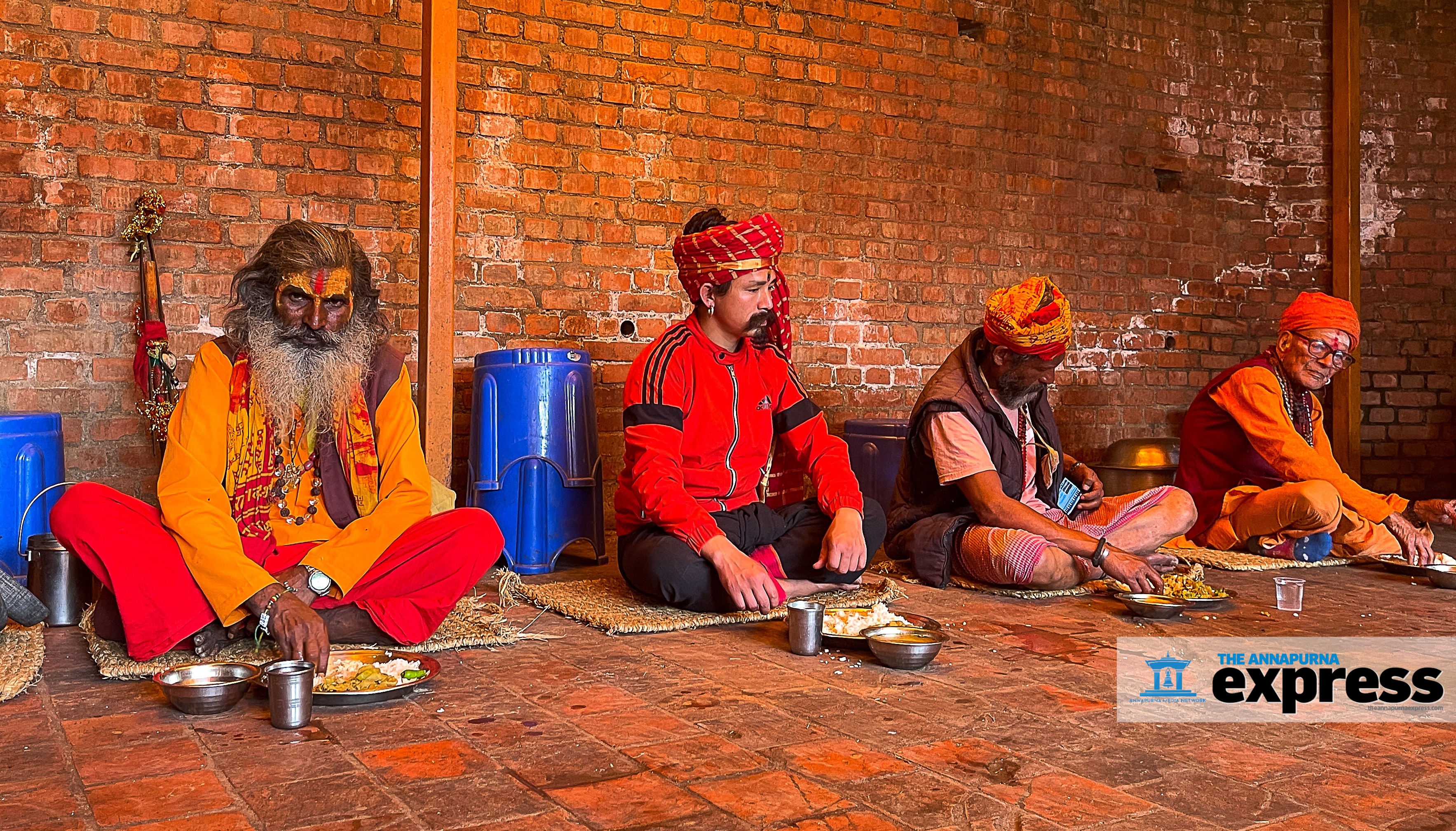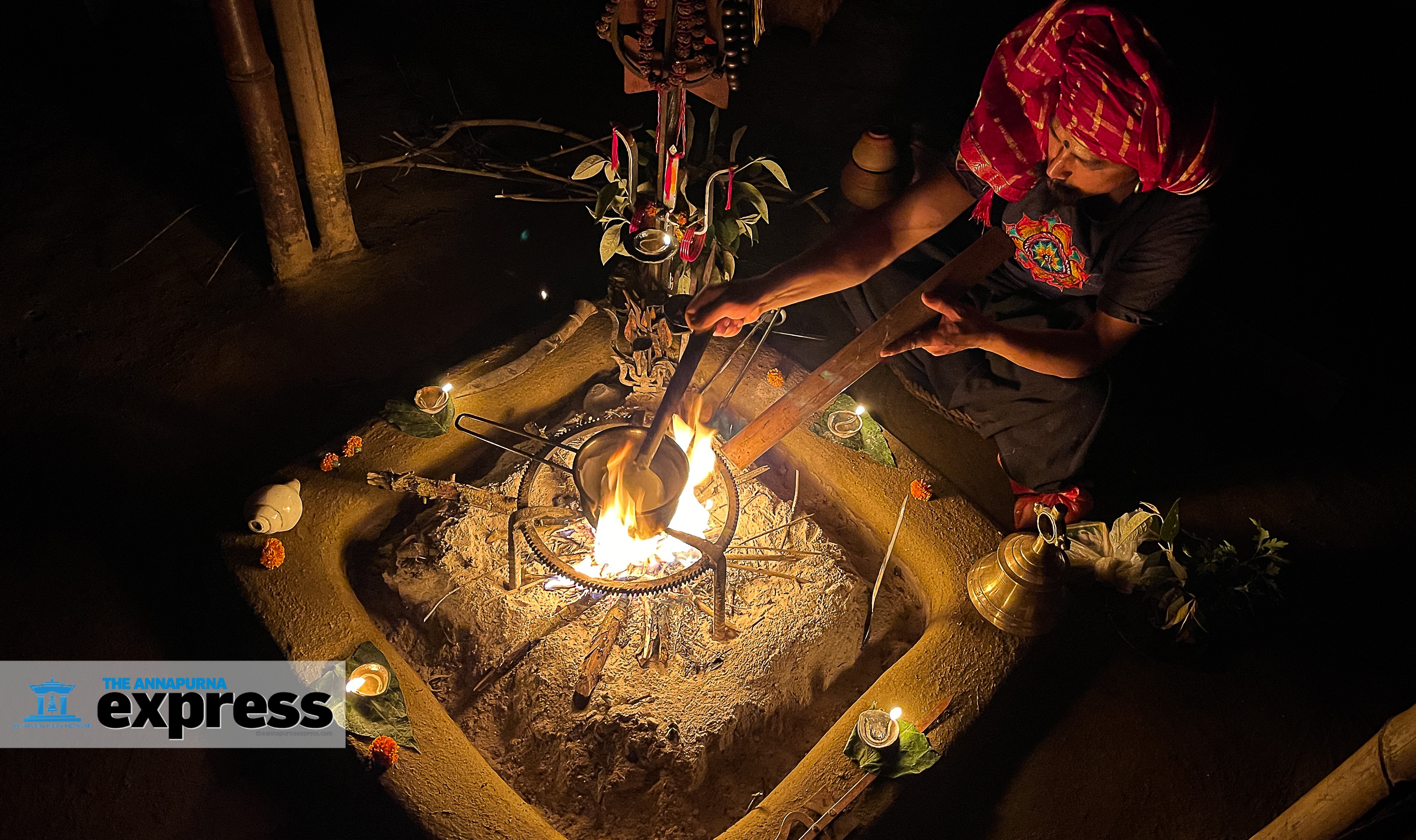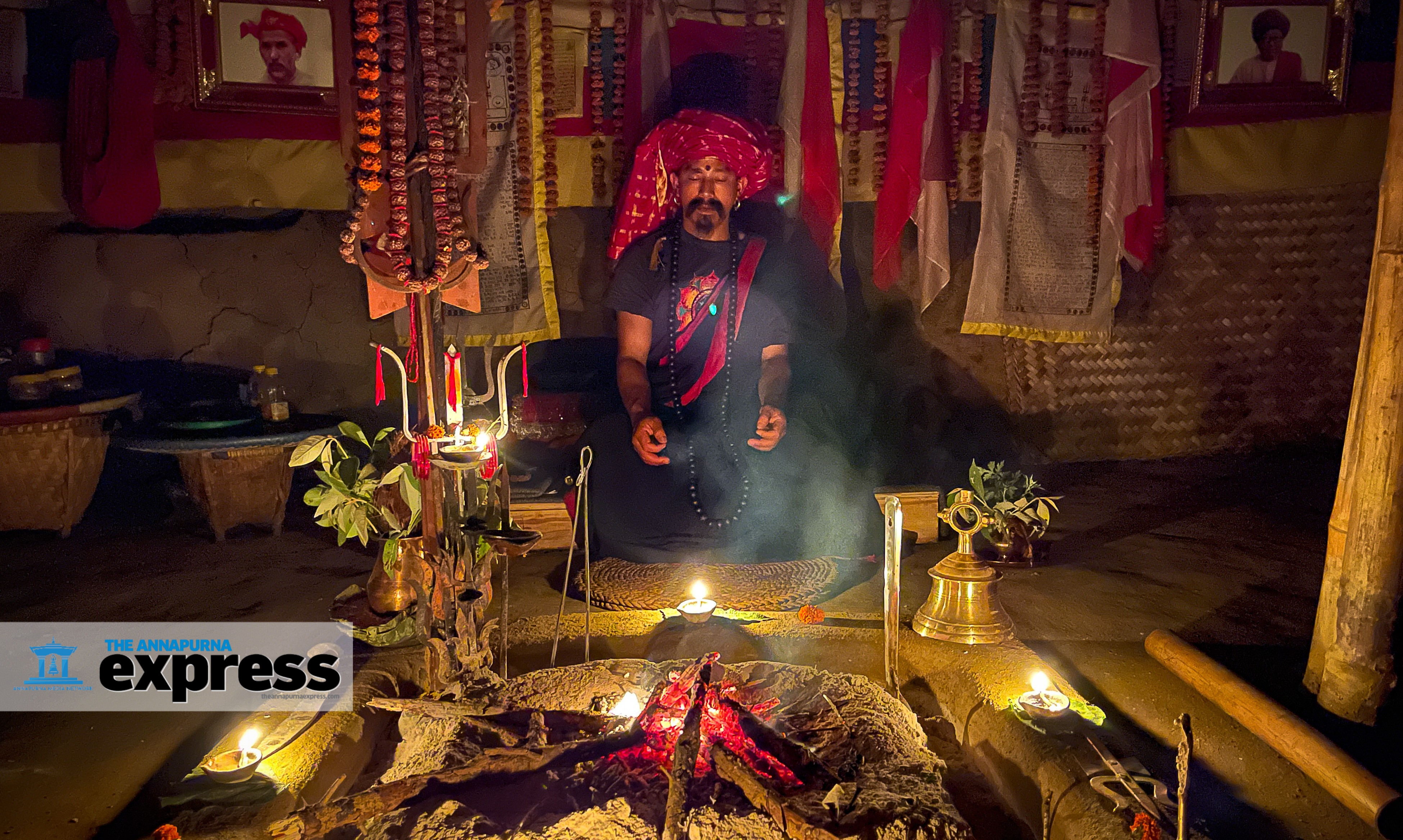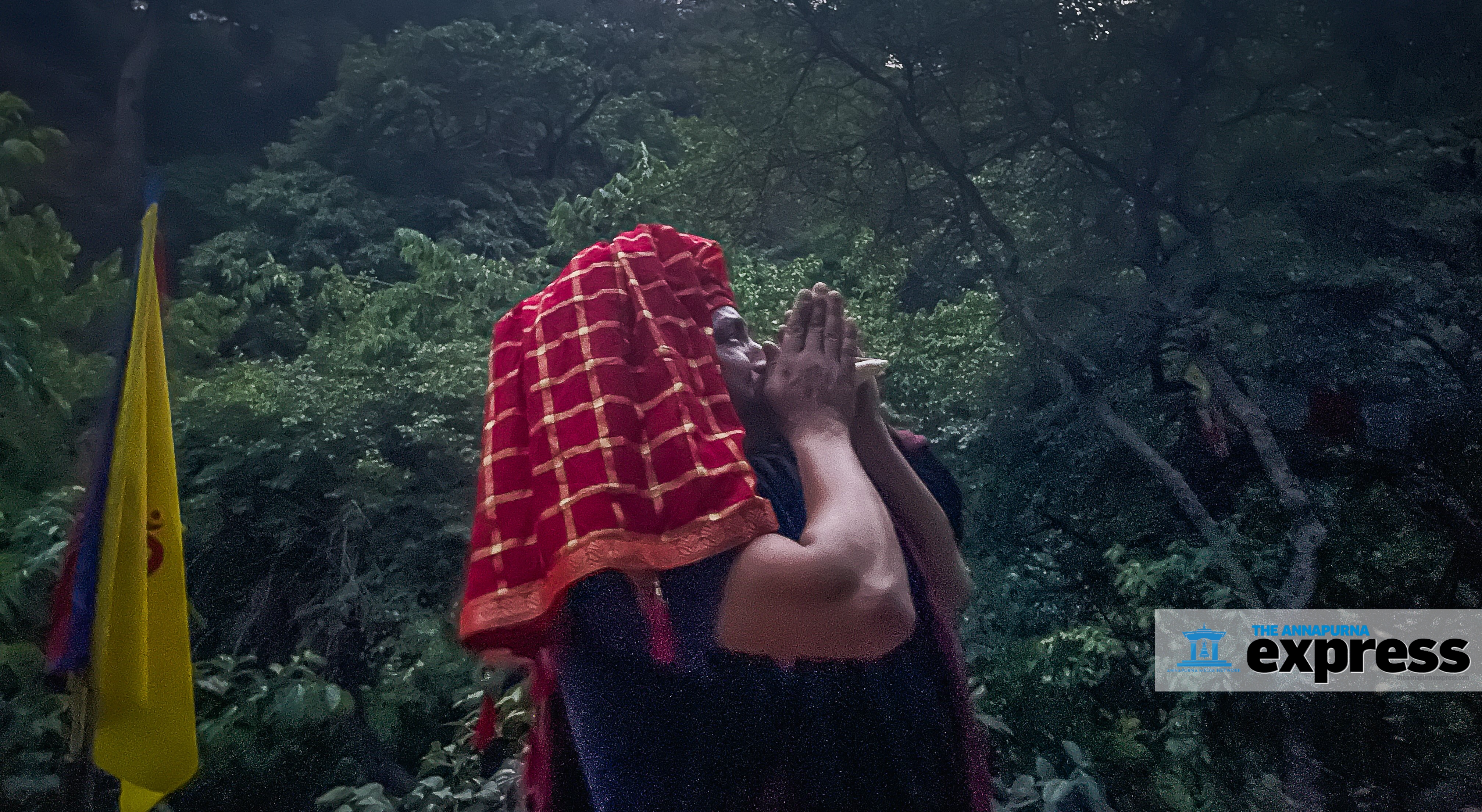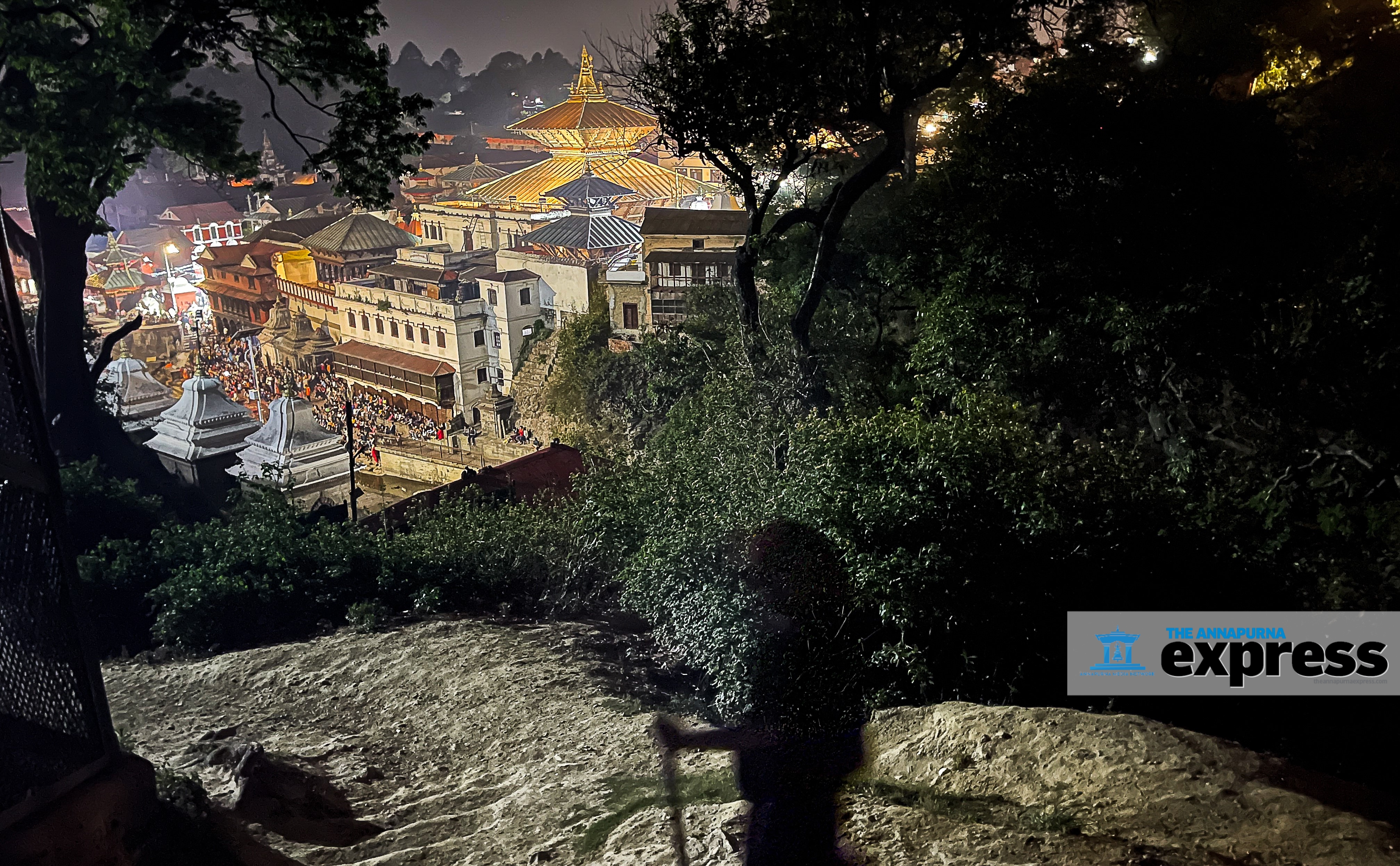Ganesh Dhakal: Giving the dead a final farewell
At Pashupati Aryaghat, the mood is always somber. People come here to cremate their loved ones at one of the many ghats by the banks of the sacred Bagmati river.
On this particular afternoon, a body is burning on a pyre and the deceased’s friends and family members are there to say their last goodbyes. As the lapping flames consume the dead, the mourning family sits there still, watching the fire intently—as though seeking some sort of catharsis, a closure. Friends and neighbors approach them to offer condolence. These exchanges are brief and in hushed tones.
While all this is happening, the cremator Ganesh Dhakal sits alone on one of the metal benches, separated from the rest. His gaze is fixed on the burning pyre. Every now and then, he gets up, moves towards the blazing heap with a bamboo pole on his hands, and prods the red-hot logs. He is making sure the body is burning properly.
Clad in a smoke-stained white dhoti, he returns to his seat and once again proceeds to look at the pyre. It’s hard to discern his emotion at this moment. He seems steely, mirthless.
I am wrong. Dhakal is very much a family man with a wife and nine children. For him burning the dead is just a job, even if an unusual one.
“I’ve been here for 40 years,” the 57-year-old says. “I came to Kathmandu to find a proper job but fate had other plans.”
Born to a poor family in Nagarkot of Bhaktapur district, Dhakal came to Kathmandu in 1982 with a dream of working for a big company. He was just 16 then.
One of the first things he did after arriving in Kathmandu was visit the Pashupatinath temple. For a young boy, looking for a job, Dhakal says, it was fortuitous that he came across the Aryaghat cremators who tasked him with carrying logs to burn bodies.
“I was desperate to make a living in the city, so I happily took the offer,” Dhakal says.
He brought logs for the cremators and watched them at their job. But being a cremator was not something he aspired to be. He still dreamt of a normal job.
But as the years went on, Dhakal says, he realized his prospect of getting other jobs was limited. To survive in the city, he still needed to earn more than what he was earning at the time.
“Becoming a cremator was my only option,” he says. “I didn’t have time or choice.”
Having burned hundreds of bodies over the decades, Dhakal says he has learned to separate his personal and professional lives. Whatever he does for a job, he leaves it at Aryaghat. At home, he takes on his family role—as a husband, a father, and the family’s breadwinner.
Dhakal lives in Chabahil with his wife, who suffers from a medical condition where she can’t walk, and their six daughters and three sons. He burns the dead so that his family can survive in Kathmandu.
When Dhakal was just starting off as a cremator, he tells me, he used to get emotional.
“I used to get carried away by the sadness of the lost lives and their grieving families that came here every day. I have learned to cope with my emotions over the years,” he says, “to see it as just something I do.”
Between our conversation, Dhakal has been approaching the pyre to give a few nudges to the burning logs with his bamboo pole. By now, my impression of him has already changed. He is very much capable of human emotions. The only thing that separates him from most others is that he can compartmentalize his emotions—hence his nonchalance to burning bodies.
“People keep asking me why I chose to be a cremator when I had a choice to get other jobs. But the truth is that any other choice wouldn’t have helped me get out of poverty,” Dhakal says. “When I decided to become a cremator, I was already sinking in poverty. This was the only skill I could easily learn and I was already working at Aryaghat.”
He earns Rs 1,500 for cremating a body, which he does once every four to five days.
Dhakal says he has long forgotten his boyhood dream of joining a big company and accepted his current situation.
“Once I got used to this work, I never thought of quitting and looking for other jobs. After all, this job helped me raise my family,” he says.
He plans on continuing so long as his health and strength permit him to do so.
The burning pyre has now crumbled into a heap of smoldering ashes. Dhakal gets up to help the priest to collect asthu (cremated remains) to hand them over to the family members.
The funeral attendees begin filing away, saying their condolences to bereaved family members. Soon, the funeral ceremony is completed, and the family members of the deceased also leave Aryaghat.
Dhakal splashes water over the cremation platform, washing away the remaining coals and ashes into the Bagmati river. Another body will soon be cremated at this spot, and Dhakal will be there for the job.
“Again, it’s just a job,” he tells me calmly, “and someone has to do it.”
‘I See You’ book review: Fast-paced but fizzles out
British author Clare Mackintosh is a former police officer who seems to know what she is writing about in her novel ‘I See You’, a crime thriller set in the elaborate labyrinth that is the London underground. Many scenes jump off the page and feel very real. It’s almost like watching a crime drama series. But, for me, the ending was a letdown despite the numerous twists and turns. It felt a little clumsy. As if the author couldn’t decide what to do, which direction to take. It makes for a rushed and a little unbelievable ending. If you are someone who’s read or watched a lot of crime stories, you can sense where things are headed.
Zoe Walker is 40 and divorced with a son (22) and a daughter (19). Her boyfriend, Simon, lives with them but her children don’t like him much. It doesn’t help that Zoe’s ex-husband, Matt, is also in the picture and still loves Zoe. Simon is jealous of Matt and her children blame her for leaving their father. Then, one day, she sees her photo in a newspaper advertisement for a dating service. The problem is she hasn’t signed up for one. As Zoe starts looking into it, she finds that women who have appeared on the advert have been victims of abuse and crime.
Enter Kelly Swift, a police officer who patrols the subway, keeping an eye out mostly for pickpockets. She was demoted to the position after she attacked a prisoner who provoked her. The man had raped her twin sister in college. Kelly learns that there’s a mysterious website that lists the subway routes of women along with their personal details. There are different subscription plans to access this information. When her team finds out that at least two women on the website have been raped and murdered, they start looking for the website owner.
The novel’s first sentence holds a lot of promise: ‘The man behind me is standing close enough to moisten the skin on my neck with his breath’. I bought the book because I felt the tension would escalate. But the danger lurks more in Zoe’s mind rather than actually out there. For the most part, it feels like Zoe is just scared and making things up, even when she’s not. And because there are only a handful of characters, it’s not that difficult to guess who might be behind it all.
Mackintosh, having served in the police force for 12 years, definitely understands the complexities of the job and it is this richly portrayed side of the story that is more interesting than the actual plot. I’d still recommend the book, purely for the vibes of the chaotic London subway system and numerous mentions of tea.
Three stars
https://www.goodreads.com/book/show/26233572-i-see-you
Thriller
I See You
Clare Mackintosh
Published: 2016
Publisher: Berkley
Pages: 388, Paperback
“Mai: A Mother’s Rage” series review: The welcome rebirth of a daily soap star
I remember Sakshi Tanwar from back in the early 2000s. As an actor, I’d never noticed her. She was just this saree-clad character, crying her eyes out every other day in a never-ending daily soap which had my mother glued to the TV every night. Never thought I’d deliberately watch her on screen.
But “Mai: A Mother’s Rage,” one of the latest releases on Netflix, gave me that chance. “Mai” is a Hindi-language thriller drama that marks the comeback of the television star who had in all these years built a rather stereotypical image. In Mai, Tanwar breaks her own norms and features in a role she has never tried before.
Sheel Chaudhary (Tanwar) is a middle-class working woman and mother.
She works as a nurse at an elderly-care home while her husband Yash (Vivek Mushran) is a freelancing handyman. All is well in the Chadudhary household until one day Sheel witnesses her daughter Supriya (Wamiqa Gabbi) being hit by a truck right in front of her eyes.
The family is in shock but soon Sheel realizes that there’s more than meets the eye in this case. Her daughter’s accident seems intentional. Determined to find the truth, Sheel starts sniffing around for clues and ends up unraveling a conspiracy that involves powerful people who could end her life. But as a grieving mother, Sheel transforms from a caring nurse to a ferocious detective who can beg, borrow or kill to get justice for her slain daughter.
This transition in Sheel’s character is where Mai’s success lies. It is abrupt but impactful and Tanwar has pulled it off with skills she has probably never shown before on screen. Creator of the web series Atul Mongia and director Anshai Lal have also ensured that Tanwar gets full support in acting as well as production.
With only six episodes, each of around 45-50 minutes, Mai is a ‘watch in a weekend’ kind of series that really entertains you for every minute you spend on it. The series moves at a medium pace without diverging from the original story. There are no backstories or sideward glances, which make this series more like a feature film that never veers off its central character.
While the writing and direction are commendable, the acting steals the show. As mentioned, as most of the characters do not get a backstory in Mai, Tanwar in the lead gets to own most of the screen time. And she deservingly takes over every bit of spotlight with her acting prowess.
We’ve talked about Sheel’s transition in the series but it’s never absolute or complete. At times, she succumbs to her husband and his family as an unimposing middle-class woman while in the next scene, she is pouring boiling water over someone she thinks might be responsible for her daughter’s murder.
Even emotionally, Sheel’s interaction with her daughter’s ex-boyfriend SP Farooque Siddiqui (Ankur Ratan), whom she partly blames for her daughter’s fate, is taxing enough. But her biggest challenge is facing the powerful businessman Jawahar Vyas (Prashant Narayanan) and his aide Neelam (Raima Sen), who could be the main culprits behind her daughter’s murder.
Also, her interactions with the police, the goons, her colleagues and her own family calls on Sheel to wear different masks to hide her true plans. This complexity in characterization and situations makes Sheel one of the strongest protagonists we have seen recently. Actor Tanwar impresses the audience she had probably never catered to in the past. Tanwar fills every layer of her character with her natural acting and is a treat throughout.
Who should watch it?
‘Mai’ is a thriller that will delight all kinds of audiences. There is little not to not like about the series, so we can recommend this to a broad audience (although the language might not be appropriate for young children). Sakshi Tanwar’s fans have probably watched it by now. Even if you have not, you’ll still enjoy it.
https://www.youtube.com/watch?v=0YsPhl3d4Cg
Rating: 4 stars
Genre: Thriller, drama
Actors: Sakshi Tanwar, Vivek Mushran, Raima Sen, Wamiqa Gabbi
Director: Anshai Lal
Run time: 5hrs approx.
Photo Story | A Maoist-abductee’s quest for enlightenment
Shri Pancha Satya Sanathan assumes Padmasana (lotus pose) with eyes shut for his morning meditation. The loincloth around his waste is the only piece of garment hiding his modesty. A Janai (sacred thread) hangs from his shoulder and runs across his naked torso, two large silver rings gleam on his earlobes, his long jet-black hair tied in a bun. He is eerily still while I photograph him. The quiet in the room is punctuated by the shutter noise of my camera and the crackling of the sticks burning above a heap of ash on the hearth between us.
Such is the daily morning routine of this sadhu (holyman) who has been living in a small bamboo-and-mud hut inside the Pashupati temple area for the past six years.

Shri Pancha Satya Sanathan was born to Dhana Bahadur Simha and Jasmati Simha in Jajarkot district of Karnali province 30 years ago. When young, he claims, he was abducted by the then Maoist rebels and taken to Ladakh, India. He recalls the time when he had to eat monkey’s meat with the insurgents in order to survive in the woods. For three years, he remained with the Maoists before returning home at the end of 1998.
“I had my spiritual awakening when I was eight,” he says. He considers his way of life a legacy of his ancestors who, like him, were Maha Siddha Purus (awakened ones).

After completing his tenth grade from Durbar High School, he came in contact with Nagar Guru Shri Rama Tripali and Dr Swami Rama Krishna Prapannachrya. For years, he served as their disciple, his spiritual gurus, learning about the Sanatan Dharma. He relinquished his family and all worldly possessions and adopted the name Shri Pancha Satya Sanathan.
“I came to Pashupati when I was 19. Before that I lived in a cave for nearly six years. Most of the time, I meditated,” he says. These days, he spends most of his time in his hut, meditating and performing rituals. In the evening he joins fellow sadhus for dinner. He is a respected figure among his peers—all of them searchers of enlightenment.
